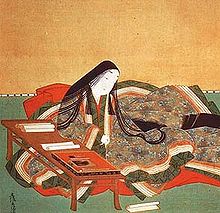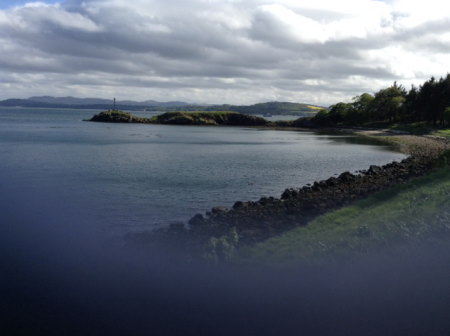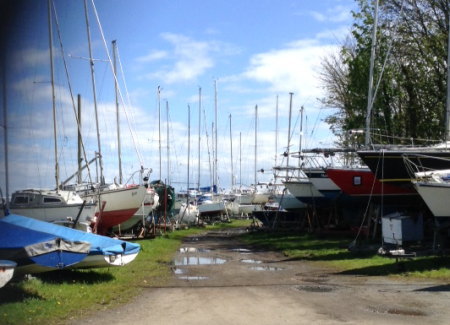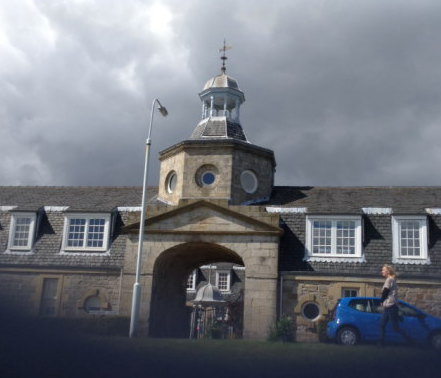Songs of Thistles
―Dalgety Bay, Scotland―
|
One of my favorite flowers is Thistle. Its needles are sharp, and its
self-defense is strong. Thistle is the flower of Scotland.
In June, along narrow paths in the pine forest near our home, thistles
are waving their purple heads in the early summer breezes.
People of Scotland might be surprised if I say that Japan has loved
Scotland so much for more than hundred and fifty years.
Without knowing the origins, we had sung Auld Lang Syne, Comin' Thro' the
Rye, Annie Laurie, My Bonnie, etc. Auld Lang Syne is a farewell song in
Japan too, and at the ceremony of commencement, graduates are sent out
with this song. Comin' Thro' the Rye became a rather sad song, thinking
of parents and friends far away in the home town. "Evening sky is
clear and autumn winds are blowing............." Everybody in Japan
knows this song even without knowing this melody is Scottish.
We have believed these are Japanese songs from the first.
 |
| Murasaki Shikibu |
My favorite Annie Laurie was made into an ode to the two extinguished ladies
of letters of some 1200 years ago! Murasaki Shikibu of "The Tales
of Genji", and Sei Shounagon of "Makura-no-Soshi". Can you
believe this?
Do you want to know why this situation happened?
In the early Meiji Era, after Japan opened its door to the western
countries, the government realized the necessity of education of music
for children. Before, the education meant writing and reading, calculation,
and other practical matters only.
But time had not yet come for new composers. So, famous foreign melodies
were borrowed and Japanese lyrics were set to them. Most of the time, the
meaning of the song became quite different from the original. These were
selected by the government to be taught at primary schools. It was the
early period of the history of Japanese school system. And it continued
quite long. That is the reason why everybody knows these Scottish melodies.
Thank you, Scotland, for lending us these beautiful tunes. Please
don't get angry because we changed them into completely different songs.
Now I would like to introduce you Noriko McTavish, who was my highschool
mate. She is now living in Dalgety Bay City in the County of Fife, Scotland.
She is an artist. She paints beautiful landscapes of Scotland.
Last month, Noriko paid a visit to her home town Karatsu, and then I asked
her to write an essay for my web site.
Please enjoy meeting Noriko and Dalgety Bay.
|
Our Town Dalgety Bay
Noriko McTavish
| |
Our town Dalgety Bay belongs to the County of Fife (the Kingdom of
Fife in old time), south-east of Scotland. By bus it takes about 40 minutes
from Edinburgh, crossing the Forth Bridge. From Dunfermline, which was
the capital of Scotland in the Middle Age, it is southward bus ride for
30 minutes.
Our town is at the mouth of the Forth River, 4 miles' long on the gentle
slope of the bank. When we stroll on the peaceful coastal path where thistles
and primroses are blooming, our hearts are set free in the light sea breezes.
 |
| peaceful Coastal Path |
Dalgety Bay was a private estate of Earl Moray until 1950.
During the two World Wars, here was the Royal Air Base, and aircrafts were
repaired at this Base.
In 1960, the Moray Family founded a housing development company together
with a private enterprise.
This town is located near Edinburgh and has a good traffic connection.
Our kind neighbor Mr. Marshall told me that the population of this town
was 500 in 1969, and at present, has grown to be 20,000, much bigger than
the first plan. Mr. Marshall made a great contribution to the town in the
1980's as a Council member.
 |
| yachts |
Since the town faces the sea, a yacht club was founded in 1970's, and every
citizen from child to adult can use it. Training of the sailing races is
also done here. Even on a snowy day, we see young people practicing sailing
if only there is enough wind. The Sport Club, Social Club, Art Club...
these are managed by membership fees and the furtherance fund from the
local body. Volunteer activities are done weekly in the Parish, like a
circle to play with handicapped children, to support mentally challenged
people, or lunch meeting with the elders.
Mrs. Marshall helps the lunch meeting every week, and I belong to the
Art Club, making more friends with the town residents.
More than half of the population of Dalgety Bay are Scottish, and others
are Welsh, English, Continental and Ethnic.
The weather is dry compared to the West Coast, so retired pension receivers
move into this town from various districts.
 |
| Stable Block, where coaches and horses were kept |
"Dalgety" is an old Celtic word which means "windy field".
Actually, when winds blow, the town snarls.
Houses are designed by 5 construction companies, with much consideration for easy living.
When you come to Dalgety Bay from Edinburgh, you take the express bus to the famous Golf Course St. Andrews.
In 1964 the Forth Road Bridge was built over the River Forth. We can witness
the glory of British construction technology when we see this new bridge
alongside the dignified figure of the Forth Railway Bridge which was completed
100 years ago. The first engineer from Japan who was invited to join in
this iron bridge construction in the Victorian age was Mr. Kaichi Watanabe
(1858-1932). Later, Watanabe was called "Father of Civil Engineering
of Japan" .
Adam Smith, the author of "An Inquiry into the Nature and Causes
of the Wealth of Nations", about whom we learned in textbooks , was
from Kirkcaldy City, and Andrew Carnegie, the American Steel King, was
born in Dunfermline. Even now this town enjoys Carnegie's blessings, and
his creed is still alive.
Dalgety Bay shows its abundant charms of a pleasant newly developed housing
town built on the ancient birthplace of the civilization of Scotland, in
the lingering light of the history of the Kingdom of Fife,
|
|
|
Thank you, Noriko, for your story of the town.
I wish I could visit there in the near future.
"Peter Pan" was written by a Scottish author. "The Treasure Island" was, too.
My conclusion is "The Scottish are the most imaginative people in
the world!"
Oh, I must not forget Loch Ness!
Wait for me, dear Nessie, until I go and see you!

|
|
|